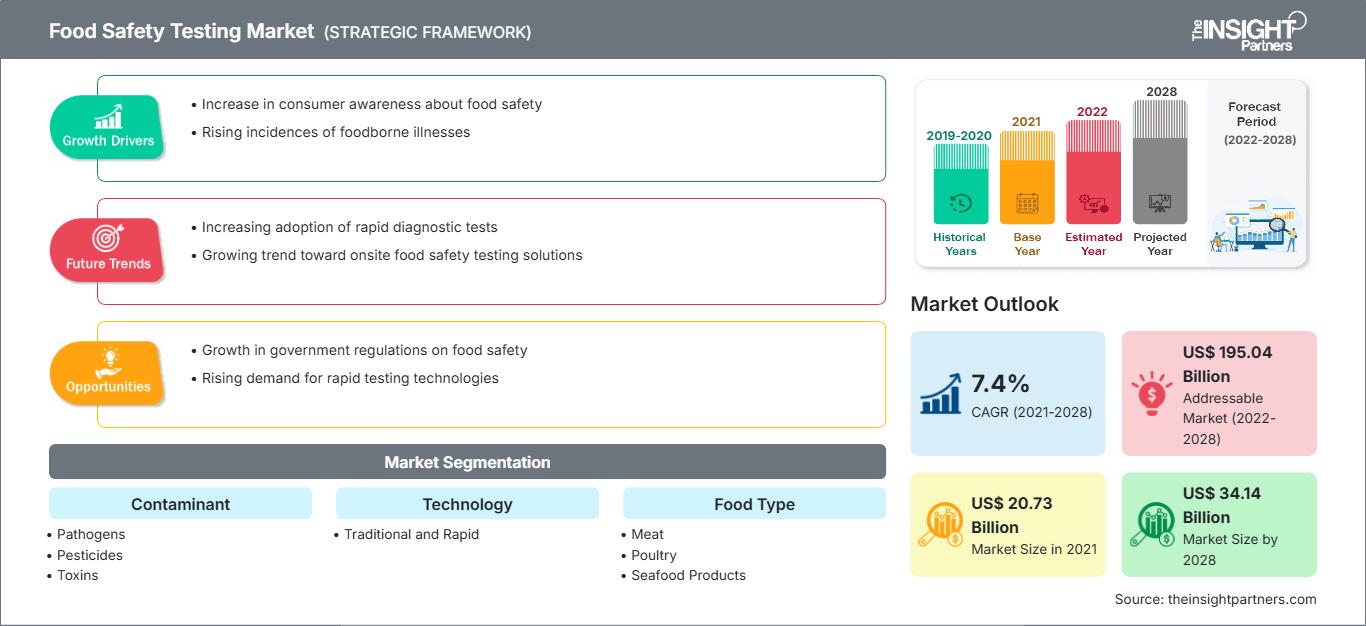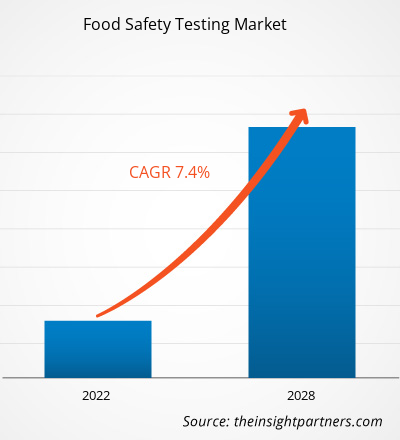The food safety testing market was valued at US$ 20,733.4 million in 2021 and is projected to reach US$ 34,142.5 million by 2028; it is expected to grow at a CAGR of 7.4% from 2021 to 2028.
Food safety testing is a scientific analysis of a food product and its contents to find information about various characteristics such as physiochemical properties, composition, and structure. The information is used to determine the safety of the product for consumption. The rising prevalence of foodborne illnesses demands food safety testing for all food and beverage products to prevent health hazards, which boosts the growth of the food safety testing market.
As per the data published by the World Health Organization (WHO), the consumption of unsafe food causes 420,000 deaths and 600 million cases of foodborne diseases worldwide each year. Foodborne diseases are preventable; hence, numerous organizations and governments lead coordinated actions to build resilient and robust food safety systems across multiple industries. Moreover, a 2018 World Bank report estimated that the economic burden through a total loss of productivity faced due to foodborne illnesses was estimated to be US$ 95.2 billion per year. Therefore, the food safety testing market is witnessing growth due to consumer awareness regarding food safety and government efforts to prevent foodborne illnesses.
Customize This Report To Suit Your Requirement
You will get customization on any report - free of charge - including parts of this report, or country-level analysis, Excel Data pack, as well as avail great offers and discounts for start-ups & universities
Food Safety Testing Market: Strategic Insights

-
Get Top Key Market Trends of this report.This FREE sample will include data analysis, ranging from market trends to estimates and forecasts.
Impact of COVID-19 Pandemic on Food Safety Testing Market
Consumer awareness is one of the major drivers of the food safety testing market across the world. The COVID-19 outbreak positively impacted the market as consumers and governments are focused on the safety and hygiene of products meant for consumption. All food & beverages sectors face challenges amid the outbreak as the SARS-CoV-2 is highly infectious and could possibly travel through food surfaces. Meat and poultry processing facilities faced distinctive challenges with respect to virus transmission as workers in several facilities across the world were infected. For instance, U.S. Department of Health & Human Services reported in July 2020 that 239 facilities in 23 states fell subject to COVID-19 infection. The total reported cases were 16,233, with 86 related deaths. Moreover, in November 2020, China reported that a frozen pork knuckle sample imported in China had triggered a new COVID-19 case in the country. Such cases of COVID-19 infections in the food industry have created apprehensions among consumers and governments, which propelled the demand for food safety testing to mitigate health risks.
Market Insights
Emergence of Foodborne Illness Outbreaks
Foodborne illnesses are toxic or infectious. They can be caused by the chemical substances, parasites, viruses entering the body through contaminated water or food. Foodborne pathogens can cause debilitating infections, such as meningitis or severe diarrhea. In some cases chemical contamination can cause long-term diseases, such as cancer, or short-term illness, such as acute poisoning. A few examples of unsafe food are raw shellfish containing marine biotoxins, vegetables and fruits contaminated with feces, and uncooked foods of animal origin. E. Coli, campylobacter, and salmonella are among the most common foodborne pathogens that affect millions of people worldwide annually and result in fatal or severe outcomes. A few symptoms of foodborne illnesses are diarrhea, abdominal pain, vomiting, nausea, headache, and fever. Moreover, listeria infection leads to death of newborn babies or miscarriages in pregnant women. Although the chances of this disease are relatively low, the fatality of listeria makes it one of the most serious foodborne infections. Vibrio cholera infects people through contaminated food or water. Its symptoms may include severe dehydration, profuse watery diarrhea, vomiting, abdominal pain, and could possibly result in death. Various types of seafood, millet gruel, vegetables, and rice have been implicated in cholera outbreaks. Therefore, the demand for food safety testing is increasing to prevent the incidence of foodborne illnesses.
Contaminant Insights
Based on contaminant, the food safety testing market is segmented into pathogens, pesticides, toxins, GMOs, and others. The pathogens segment accounted for the largest market share in 2020, and the GMOs segment is expected to register the highest CAGR in the market during the forecast period. Pathogen testing is done to eliminate or reduce the incidence of foodborne illnesses. The elimination is considered so essential that the testing process is implemented in the very step of food production to ensure food safety and sanitation. A few most common pathogens that can cause foodborne illnesses are E. coli, listeria, and salmonella. Pathogen testing can be done using traditional techniques or newer ones. The traditional techniques use conventional cell culture standards, whereas the newer techniques include laser-based or spectrometric diagnostics. Since pathogens are one of the most common reasons for foodborne illnesses, the pathogen segment holds the largest market share in the food safety testing market. Also, the market for this segment is expected to grow during the forecast period due to the growth of the food & beverages industry.
Technology Insights
Based on technology, the food safety testing market is bifurcated into traditional and rapid. The rapid segment accounted for a larger market share in 2020, and the same segment is expected to register a higher CAGR in the market during the forecast period. Major market players are introducing innovative products in the rapid testing owing to the high demand for the service. For instance, in 2009, bioMérieux, Inc. introduced TEMPO, an automated system for the enumeration of microorganisms in food. The automated system eliminates the tedious manual steps involved in most probable number (MPN) method using a miniature card. Therefore, the automated test offers simple traceability and high throughput, and it is also a cost-effective alternative to manual testing. Moreover, the company has also introduced recombinant bacteriophage technology that is used for food-borne pathogen detection, which has reduced the time to grow bacteria at a detectable level. Such rapid tests prove to be useful in terms of cost saving for food manufacturers as the waiting period for batches in inventory is significantly reduced. Thus, the multiple benefits of rapid testing is expected to fuel the market growth for this segment during the forecast period.
Food Type Insights
Based on food type, the food safety testing market is segmented into meat, poultry, and seafood products; dairy products; cereals and grains; processed food; fruits and vegetables; and others. The meat, poultry, and seafood products segment accounted for the largest market share in 2020, and the fruits and vegetables segment is expected to register the highest CAGR in the market during the forecast period. The meat, poultry, and seafood products testing includes testing for contaminants as well as for food adulteration wherein one meat type is adulterated with other meat types. The products may be tested for ash, fat, moisture, protein/nitrogen, heavy metals, pesticides, antibiotics and drugs, salt, chloride, and nitrates and nitrites. Meat products are most likely to get contaminated or defected considering the shelf life and nature of these products. Therefore, the testing for these products is mandatory in all countries. The market for this segment is expected to grow due to the rising consumption of meat, poultry, and seafood products across the world.
A few players operating in the food safety testing market are SGS SA, Eurofins Scientific, Intertek Group Plc, TÜV SÜD, AES Laboratories Pvt. Ltd., TÜV NORD GROUP., Bureau Veritas, ALS Limited, NEOGEN Corporation, and AsureQuality. These companies provide a wide range of product portfolio for the market. The companies have their presence in the developing regions, which provides lucrative opportunities for the food safety testing market growth. The market players are developing high-quality and innovative products to fulfil the customer’s requirements.
Report Spotlights
- Progressive industry trends in the food safety testing market to help players develop effective long-term strategies
- Business growth strategies adopted by developed and developing markets
- Quantitative analysis of the food safety testing market from 2019 to 2028
- Estimation of global demand for food safety testing
- Porter’s five forces analysis to illustrate the efficacy of buyers and suppliers operating in the industry
- Recent developments to understand the competitive market scenario
- Market trends and outlook as well as factors driving and restraining the growth of the Food safety testing market
- Assistance in decision-making process by highlighting market strategies that underpin commercial interest, leading to the market growth
- The size of the food safety testing market size at various nodes
- Detailed overview and segmentation of the market, as well as the food safety testing industry dynamics
- Size of the food safety testing market in various regions with promising growth opportunities
The regional trends and factors influencing the Food Safety Testing Market throughout the forecast period have been thoroughly explained by the analysts at The Insight Partners. This section also discusses Food Safety Testing Market segments and geography across North America, Europe, Asia Pacific, Middle East and Africa, and South and Central America.
Food Safety Testing Market Report Scope
| Report Attribute | Details |
|---|---|
| Market size in 2021 | US$ 20.73 Billion |
| Market Size by 2028 | US$ 34.14 Billion |
| Global CAGR (2021 - 2028) | 7.4% |
| Historical Data | 2019-2020 |
| Forecast period | 2022-2028 |
| Segments Covered |
By Contaminant
|
| Regions and Countries Covered |
North America
|
| Market leaders and key company profiles |
|
Food Safety Testing Market Players Density: Understanding Its Impact on Business Dynamics
The Food Safety Testing Market is growing rapidly, driven by increasing end-user demand due to factors such as evolving consumer preferences, technological advancements, and greater awareness of the product's benefits. As demand rises, businesses are expanding their offerings, innovating to meet consumer needs, and capitalizing on emerging trends, which further fuels market growth.

- Get the Food Safety Testing Market top key players overview
Food Safety Testing Market – by Contaminant
- Pathogens
- Salmonella
- E.coli
- Listeria
- Others
- Pesticides
- Toxins
- GMOs
- Others
Food Safety Testing Market – by Technology
- Traditional
- Rapid
- PCR-based Testing
- Immunoassay-based Testing
- Others
Food Safety Testing Market – by Food Type
- Meat, Poultry, and Seafood Products
- Dairy Products
- Cereals and Grains
- Processed Food
- Fruits and Vegetables
- Others
Company Profiles
- SGS SA
- Eurofins Scientific
- Intertek Group Plc
- TÜV SÜD
- AES Laboratories Pvt. Ltd.
- TÜV NORD GROUP.
- Bureau Veritas
- ALS Limited
- NEOGEN Corporation
- AsureQuality
Frequently Asked Questions
Which technology segment is the fastest growing in the global food safety testing market?
In 2020, which country held the largest market share in global food safety testing market?
Which category segment accounted for the largest share in the global food safety testing market?
Can you list some of the major players operating in the global food safety testing market?
What is the key driver for the growth of the global food safety testing market?
In 2020, which region held the largest share of the global food safety testing market?
- Historical Analysis (2 Years), Base Year, Forecast (7 Years) with CAGR
- PEST and SWOT Analysis
- Market Size Value / Volume - Global, Regional, Country
- Industry and Competitive Landscape
- Excel Dataset
Recent Reports
Related Reports
Testimonials
Reason to Buy
- Informed Decision-Making
- Understanding Market Dynamics
- Competitive Analysis
- Identifying Emerging Markets
- Customer Insights
- Market Forecasts
- Risk Mitigation
- Boosting Operational Efficiency
- Strategic Planning
- Investment Justification
- Tracking Industry Innovations
- Aligning with Regulatory Trends





















 Get Free Sample For
Get Free Sample For